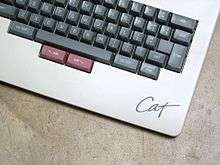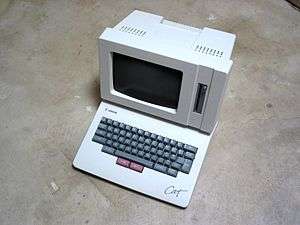Canon Cat
|
Canon Cat. | |
| Developer | Jef Raskin |
|---|---|
| Manufacturer | Canon Inc. |
| Type | task-dedicated, desktop computer |
| Release date | 1987 |
| Introductory price | 1495 US$ (today $3119.18) |
| Discontinued | 1987 |
| Operating system | Forth |
| CPU | Motorola 68000 @ 5 MHz |
| Memory | 256 KB of RAM |
| Storage | 3½-inch 256 KB floppy disk drive |
| Display | 9-inch (229 mm) black-and-white monitor |
| Connectivity | Internal 300/1200 bit/s modem |
| Weight | 17 pounds (7.7 kg) |
The Canon Cat was a task-dedicated, desktop computer released by Canon Inc. in 1987 at a price of US$1495. On the surface it was not unlike the dedicated word processors popular in the late 1970s to early 1980s, but it was far more powerful and incorporated many unique ideas for data manipulation.
Description
The Canon Cat was primarily the creation of Jef Raskin, originator of the Macintosh project at Apple. After leaving the company in 1982, he began designing a new computer closer to his original vision of an inexpensive, utilitarian "people's computer"; BYTE in 1987 described the Cat as "a spiritual heir to the Macintosh".[1] It featured a text user interface, not making use of any mouse, icons, or graphics. All data was seen as a long "stream" of text broken into several pages. Instead of using a traditional command line interface or menu system, the Cat made use of its special keyboard, with commands being activated by holding down a "Use Front" key and pressing another key. The Cat also used special "Leap keys" which, when held down, allowed the user to incrementally search for strings of characters.

The machine's hardware consisted of a 9-inch (229 mm) black-and-white monitor, a single 3½-inch 256 KB floppy disk drive and an IBM Selectric–compatible keyboard. It used a Motorola 68000 CPU (like the Macintosh, Lisa, Atari ST and Amiga) running at 5 MHz, had 256 KB of RAM, and an internal 300/1200 bit/s modem. Setup and user preference data was stored in 8 KB of non-volatile (battery backed-up) RAM. The Cat's array of I/O interfaces encompassed one Centronics parallel port, one RS-232C serial port (DB-25), and two RJ11 telephone jacks for the modem loop. The total weight of the system was 17 pounds (7.7 kg).
An extensive range of application software was built into 256 KB of ROM: standard office suite programs, communications, a 90,000 word spelling dictionary, and user programming toolchains for Forth and assembly language.
Often considered a text-only machine, the Cat included graphics routines in ROM as well as connectors for a mouse or other pointing device that were never used.[2]
There was a software project no longer under development, initiated by Raskin, to develop a similar yet even more capable system for today's computing systems. The project (called Archy) was designed to eventually replace current software interfaces.
See also
- Jupiter Ace, a British home computer of the early 1980s that like the Cat used Forth
References
- ↑ Shapiro, Ezra (October 1987). "A Spiritual Heir to the Macintosh". BYTE. p. 121. Retrieved 4 August 2014.
- ↑ apple-history.com / gui discussion :: jef raskin response
- Notes
External links
- DigiBarn Systems: Canon Cat
- OLD-COMPUTERS.COM Museum: Canon Cat
- CanonCat.org
- Canon Cat Quick Reference Card
- Canon Cat Computer User Manual
- Canon Cat Computer Reference Manual
- Canon Cat Computer Repair Manual
- Promotional Video for Leap and Canon Cat (If broken link: video is titled "Leap Technology")
- SwyftCard Quick Reference Card (for the earlier SwyftCard, giving the Apple II somewhat similar functionality)
- SwyftCard guide, glossary, and reference manual
- BYTE SwyftCard review

